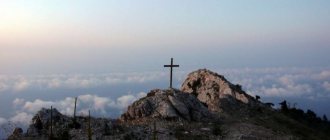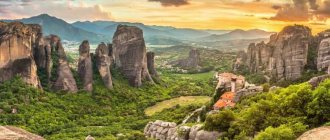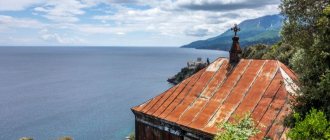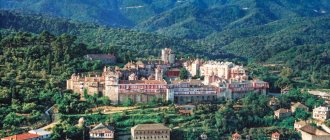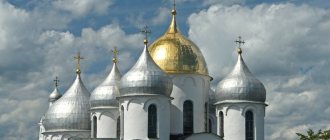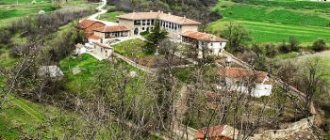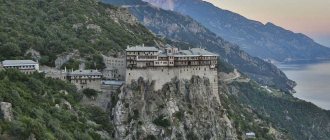Perhaps the most unusual country in the European Union, which was able to preserve and carry through the centuries the cultural heritage and traditions of its people, actively demonstrating the spiritual wealth of its ancestors to this day, is Greece. So, even after 2000 years, almost every educated person in the world knows about the 12 labors of Hercules, myths about the ancient Greek gods, and the population of this southern state in almost any corner of their country can provide their guests with evidence of the existence and development of their civilization and ancient culture.
We should also not forget that the Greeks are among the first Christians on earth, and in the country there are many Orthodox shrines, the inhabitants and guardians of which still honor all the traditions of their righteous ancestors. One of these places is Mount Athos.
What is Athos, historical facts
The holy mountain in Greece owes its name to the legend of the giant Athos, who dared to fight Poseidon himself, and in order to defeat him, he lifted a huge block of stone and threw it at the mythical god, but he dodged, and the rock, flying past, firmly stuck into the ground, receiving the name of Mount Athos is Greece.
The first settlements in the Greek monastery of Athos began 3,000 years ago in the form of the Thracians, and the Greeks chose the area only after another 500 years. The secluded area, difficult accessibility of other people and excellent conditions for serving God made this place the main refuge for the monks of Greece. They founded an entire settlement on the mountain, which led in 1144 to the official name of this area “Holy Mount Athos”.
Panorama of Athos
According to ancient legend, at the very beginning of our era, in 49 after the resurrection of Christ, the Mother of God traveled with the Apostle John across the Mediterranean Sea, and their ark landed on the shores of Athos, and when the All-Tsaritsa set foot on these lands, she liked them more than any other place on the planet, and God, seeing this, made her the patroness of the mountain and the surrounding areas. Since then, the land has come to be considered holy, and millions of Orthodox pilgrims from all over the world strive to set foot in the monastery of the Mother of God herself.
Important! According to an ancient tradition that has existed on Mount Athos for more than 1,500 years, not a single woman to this day can get into the Shrine. This is due to the vow of celibacy of the monastic population of the mountain, and no woman can accidentally awaken the instincts of the men living there in order to prevent sin. The legislation of the monastic state provides for liability for those representatives of the fair sex who dare to enter the territory of the sacred mountain without the knowledge of the head of the community - up to 1 year in prison.
However, the service personnel, among whom there is a small percentage of women, have the opportunity to stay on Mount Athos if she is a widow or virgin over 40 years old. Children under 12 years of age are also not allowed to climb the mountain or visit the monasteries.
Monasteries and settlements of the Holy Mountain
The map of Holy Mount Athos contains 20 monasteries:
| Number in hierarchy | Name Russian | Name in Greek. | Base, century | Affiliation |
| 1 | Great Lavra | Μεγίστη Λαύρα | X | Greece |
| 2 | Vatoped | Βατοπέδι | X | Greece |
| 3 | Iversky | Ιβήρων | X | Georgia, later Greece |
| 4 | Hilandar | Χιλανδαρίου | XII | Serbia |
| 5 | Dionysiatus (Nea Petra) | Διονυσίου | XIV | Greece |
| 6 | Kutlumush | Κουτλουμούσιου | XIV | Greece |
| 7 | Pantocrator | Παντοκράτορος | XVIII | Greece |
| 8 | Xyropotamus | Ξηροποτάμου | X | Greece |
| 9 | Zograf | Ζωγράφου | X | Bulgaria |
| 10 | Dohiar | Δοχειαρίου | X | Greece |
| 11 | Caracal | Καρακάλλου | XI | Greece |
| 12 | Filofey | Φιλοθέου | X | Greece |
| 13 | Simonopetra | Σίμωνος Πέτρα, Σιμωνόπετρα | XIII | Greece |
| 14 | St. Paul's | Αγίου Παύλου | IX | Greece |
| 15 | Stavronikita | Σταυρονικήτα | X | Greece |
| 16 | Xenophon | Ξενοφώντος | X | Greece |
| 17 | Gregoriat | Γρηγορίου | XIV | Greece |
| 18 | Esphigmen | Εσφιγμένου | X-XI | Greece |
| 19 | St. Panteleimon | Αγίου Παντελεήμονος or Ρώσικο | XI | Russia |
| 20 | Konstamonite | Κωνσταμονίτου | XI | Greece |
The architecture of the monasteries with high, blank outer walls recalls difficult times, when they were often subjected to devastating raids.
In addition to them, the map of Mount Athos includes 12 monasteries (monastic-type settlements), cells (large monastic settlements), kalitva, kathisma, hesychasteria - hermitage. Many of them are located in the inaccessible Karulya area. Usually pilgrimage routes do not pass through these places. Signs installed near dangerous paths warn about this.
Brief geographical information about Athos
Why are women prohibited from visiting Mount Athos?
Mount Athos on the map of Greece and the adjacent territories at the foot belong to the Chalkidiki Peninsula, originating near the city of Thessaloniki and resembling the outline of the three-toed paw of an unprecedented beast, and the Athos area itself is the easternmost (right on the map) part of the peninsula .
Greece, Mount Athos, although it is part of the state, is not part of its jurisdiction, and within the monastic community there is its own structure of power and political hierarchy. Thus, this area can be called a kind of Orthodox Vatican, and the administrative center in all state papers is called Carrier.
Monastery of the Great Lavra
This relatively small area enjoys a mild subtropical climate with good weather, pleasant and healthy Mediterranean air, where temperatures rarely fall below zero, and winters are characterized by only rain, but summers are swelteringly hot, which can only be tolerated by the influence of the sea breeze. The best place for Orthodox Christians is the off-season (from May to October), when the heat no longer exhausts the traveler so much, and the rains have not yet come into their own to spoil the impression of visiting shrines.
Everything that the monks need - olives, grapes, bread, fruit crops, spring water - they obtain independently to meet their needs, running their own farm on the slopes of the mountain and thereby being completely self-sufficient.
Main attractions of Athos
Ouranoupolis (Greece)
Over the past 3,000 years, many monastic communities have been formed on Mount Athos, united by their ideas, spiritual values and standard of living. The main shrines of the mountain include several groups of monasteries with a total of 20 units, and this figure has not changed for years, since the legislation of this theocratic state does not allow accepting anyone into its community. Thus, the following 5 monastic clans are located on the island:
- Athos monastery in Greece of the Great Lavra, Dochiar Cathedral, Xenophon temple complex.
- The shrine of Caracalla, the Church of Vatopedi, the monasteries of Philotheus and Pantokrator.
- One of the most famous Orthodox monasteries in the world is Iversky, and the adjacent Simonopetra, Philotheus and Pantokrator.
- A little further away, on the opposite slope of Mount Athos, are the churches of St. Paul, Hilindar and Grigoriat, and behind them rises Xiropotamus.
- The last group also includes 4 monasteries - Konstamonit, the largest of all on the mountain - St. Panteleimon and the surrounding Dionysiatus and Zograf.
Important! In total, the population of the Orthodox shrine cannot exceed 1,500 people, who live in 12 monasteries, each with its own monastic clan and devote their lives to religious teachings and ascetic principles in clothing, food, ideology of material and spiritual values.
Iversky Monastery
Administrative status
The special status of the Holy Mountain is guaranteed by the Greek constitution, making the monastic republic essentially a state within a state. Legislative and executive power is exercised by assemblies where all monasteries are represented. The secular government is represented by the Greek governor. Many social functions (mail, law enforcement, etc.) are also carried out by Greek services.
The administrative border beyond which the Holy Mountain begins is in an area called Megali-Vigla (Μεγάλη Βίγλα - Great Guard) near the city of Ouranoupolis. At this point, the flat part of the peninsula gives way to a rocky ridge, which rises to the southeast ending in the highest mountain, raised to a height of 2033 m.
Even time does not flow here like it does elsewhere. Most monasteries adopted the Byzantine tradition of calculating time, according to which the day begins at sunset. And in the Iversky Monastery, on the contrary, the day begins at dawn.
Organized excursions to Mount Athos
Many Russian and Greek travel companies offer our compatriots assistance in organizing trips to Athos, ranging from a simple one-day sightseeing tour to 10-day pilgrimage tours.
Halkidiki (Greece): attractions
Thus, the main companies offering trips to Mount Athos with a Russian-speaking guide are the pilgrimage service “Tovia”, the large Greek tour operator Greece Transfers and another one – GidvGreece.
Almost all companies when visiting Mount Athos, depending on the amount of time, offer the following programs for tourists and pilgrims:
- Request a visa from the Athos authorities and obtain it.
- Ground transfer from any major city in Greece to the port of Athos Ouranoupolis.
- Transfer to a special ship and cross the bay to the ancient harbor of Daphne.
- Transfer from the port to the mountain by minibus.
- A tour of the monasteries, depending on the trip program, familiarizing yourself with the history of each of them, the traditions, culture and customs of a particular monastic community, as well as traveling through the territories adjacent to the monasteries. From afar, men will be able to see the life and everyday life of the monks.
Important! During the excursion, you must strictly follow the instructions of the Russian-speaking guide so as not to harm the religious activities of the shrine and the traditional way of life of the monks.
Monasteries on Mount Athos
The right to enter Mount Athos
As mentioned above, only the male part of the population has the right of passage to the sacred mountain range, and even then they are required to obtain a special pass - diamonitirion, and in order to order it, the following steps must be taken:
- Submit an application to visit the shrine to the pilgrimage center of Mount Athos no later than 1 month before the intended trip. The traveler can leave a request on the portal.
- Send there a copy of the first spread of your passport.
- Upon arrival by transfer or personal vehicle in Ouranoupolis, you must contact the pilgrimage office and obtain your visa.
- In order to obtain a diamonitirion, the applicant is required to pay a consular fee in the form of a donation in the amount of 25 euros (as of August 2021).
- For those tourists who have not taken care of their pass to the monastic monastery in advance, numerous travel companies operate near Mount Athos, issuing the right to entry in an accelerated manner, however, the cost increases 4 times - up to 100 euros for each man or boy.
Important! A one-time right to enter the shrine gives each traveler the opportunity to stay and live on the territory of any of the monasteries in guest rooms for 96 hours, as well as participate in services and leave notes for health in Greek, reading prayers and performing services. The provision of shelter and bed in the monastery is not paid for by the pilgrim, however, tradition has established that, as a form of gratitude, the traveler should purchase something from the monastery’s products - wines, souvenirs, etc. If necessary, the period of validity of the visa can be extended in Ouranoupolis, in the same the place where the document is received.
Ferry to Athos
In addition to the monasteries, there are 12 hermitages scattered throughout the Holy Mountain (often large settlements, no different from monasteries in anything other than their formal status), as well as: cells (in Russian literature usually called “cell monasteries” - extensive monastic settlements with a cultivated plot of land), kaliva (settlement without land), kathisma (single settlements, usually near the mother monastery), hesychasteria (those who strive for complete solitude, sometimes in a cave, labor in them). There are many of the latter in the south of the peninsula and in the Karulya area. The fundamental difference from the monastery of all other settlements is their lack of rights to land ownership, which puts them in direct dependence on the monastery, which owns their land. Until the early 1990s, the monasteries on Mount Athos were both communal (in which the monks live on the general monastic allowance) and full-time (private). After the transfer of Pantokrator to a hostel in 1992, all monasteries became hostels. However, many monasteries still remain special.
We will begin our pilgrimage along the western coast of Athos.
The first monastery we will visit is Zograf.
Pilgrims and monks usually reach the Holy Mountain by sea. A double-deck ferry runs daily from the port of Ouranopolis to the Daphni pier on Athos and back. Many monasteries have their own small piers and moorings, which can be reached by small longboat or boat. The Athos Arsana (pier) is also located at the Bulgarian Zograf Monastery.
From here to the monastery it takes about an hour and a half to walk. As soon as the ferry sails away and disappears, there is silence here. Athonite everyday life, woven from prayerful pauses filled with silence, invites arriving pilgrims to experience through them the beautiful severity and silent beauty of the otherworldly.
The Zograf Monastery was founded at the beginning of the 10th century by three brothers of the royal family from Ohrid of Bulgaria. They were waiting for a sign from the Lord to which saint to dedicate the monastery. In 919, on a board prepared for icon painting and standing in the vestibule of the church, in the morning the image of the Holy Great Martyr George appeared spontaneously.
At the same time, in the Fanuel Monastery in Cappadocia, there is an ancient icon of the Great Martyr. Georgia turned into an empty board. St. appeared to the abbot of the Fanuel Monastery in a dream. George said that he was going to Mount Athos to the monks who were turning their prayers to him. Having learned about the appearance of the icon, the inhabitants and guests of Athos came to venerate the image. Not far from the monastery there is a cave of St. Cosmas of Zograf (1323) and a cell, to which stone steps now lead. Saint Cosmas prayed for a long time before the icon of the Most Holy Theotokos, later called “The Hearer.”
Yielding to his fervent prayers, the Mother of God, during his reading of the canon, turned to the Infant Christ, whom she held in her arms, and asked him to give the humble Cosmas the desired instruction. In response, the Infant Christ commanded Cosmas to go to the mountains, to the remote Athos cave, where he subsequently labored until the end of his earthly days.
Another wonderful incident is known from the history of the Zograf Monastery. One monk, daily reading the akathist: “Rejoice, Unmarried Bride,” heard: “Rejoice, too, elder, for you are honored to warn your Zograph brethren: those who are ready to accept the crown of martyrdom, let them remain in the monastery, and the rest should flee.” Following the elder, the icon of the Mother of God, later called the “Forerunner” or “Akathist”, came to the monastery, carried by angels. The 26 monks who remained in the monastery were burned by the Latins. At the site of the fire, the “Forerunner” icon was preserved incorrupt. A year later (in 1277), during a memorial service, 26 rays of light descended from the sky onto the ashes.
When pilgrims enter any Greek (including Athonite) monastery, the first thing they do is enter the gatehouse, the so-called archondarik. There is always a monk on duty there - an archondarite. According to Athonite custom, the archondarite first of all offers you reinforcement - a glass of cold water, a piece of Turkish delight (or a spoonful of jam), a shot of aromatic grape vodka - crayfish and a cup of sweet coffee. This is an immutable law. This set is always served to the traveler, at any time of the year, both on fasting and fasting days, except perhaps Good Friday. And only after that the conversation begins.
If you stay in the monastery overnight, you are asked to sign in a thick guest book - first name, last name, father's name, year of birth, religion, country and city, profession. In the evening, one of the favorite pastimes of Athonite pilgrims is to read the guest book and look for fellow countrymen and acquaintances there. Every time you find a familiar name, you rejoice, as if you had met a loved one in person.
The next monastery we will visit is the Serbian monastery of Hilandar.
Hilandar Monastery was founded in the 10th century. By the middle of the 12th century it fell into disrepair. In 1198, the Byzantine Emperor Alexy III gave the monastery “in eternal possession” to Serbia. Hilandar brought the Slavic spirit into the Athos monasteries, where services began to be performed in Slavic languages.
The main shrine is the “Three-Handed” icon of the Mother of God, which was located in the 8th-13th centuries in the Palestinian Lavra of St. Savva the Sanctified. This image, together with the pastoral staff of St. Sava was given to St. Savva of Serbia according to the word of St. John of Damascus, who for five centuries predicted the arrival of Savva of Serbia to the Lavra of St. Savva. Saint John of Damascus was slandered out of revenge by the iconoclast emperor before the Prince of Damascus, and he ordered the right hand of the saint to be cut off. The innocent sufferer asked for a severed hand and, applying it to the wound, prayed with tears to the Mother of God for healing so that he could continue to defend Orthodoxy. In a subtle dream, the Mother of God appeared to the sufferer and healed him, commanding him to continue his work. Amazed by the mercy of the Mother of God, the Monk John minted a silver image of a hand and attached it to Her icon, which became known as the “Three-Handed One.” The saint retired to the Lavra of St. Savva the Sanctified, taking with him the miraculous shrine. According to the revelation of the Mother of God, in the Hilandar monastery she resides above the abbot’s place, being the Abbess of the monastery.
Permission (diamonitirion) to stay on Mount Athos is issued for four days. These four days the pilgrim can stay on the Holy Mountain and enjoy the hospitality of any monastery. You can stay longer if one of the monasteries vouches for the pilgrim before Kinot (the government of the monastic republic) and agrees to receive him as a monastic guest.
From the Zograf Monastery it is a 2.5 kilometer walk to the next closest monastery. This is a Greek monastery - Konstamonite.
A delightful picture opens before your eyes: on the left are expanses of green valleys, regular squares of vineyards and hilly hills, covered with lush vegetation of southern forests and shrubs. And behind all this kingdom of greenery and vibrant colors of the earth, a beautiful, azure, slightly swaying sea sparkles and sparkles, completely surrounded by a frame of shores.
The Konstamonit Monastery is dedicated to the Holy First Martyr Stephen. According to early legend, the founder of the monastery was Emperor Constantine the Great. After the death of the Emperor, his son Constance completed the work begun by his father. It is possible that Konstamonite was intended as an Episcopeia, a small monastery that housed the residence of the local bishop and a catechetical center for Greek converts to Christianity.
The cathedral, dedicated to St. Stephen, was built in 1860 - 1871. It housed four more temples. Behind the monastery gates there are five more small churches and chapels. In addition, Konstamonit has cells in Kareya. The monastery has three miraculous icons: the Mother of God “Portaitissa”, with which the miracle that happened through the intercession of the Mother of God with the abbot of the monastery Simeon, when he went to Russia to collect donations in 1872-76, is associated; the second icon is the image of St. Stephen, which miraculously arrived at the monastery from Jerusalem during the era of iconoclastic persecution; the third icon is the Mother of God “Antiphonetria” (“Giver of the answer”). The monks say that one day, on the feast of St. Stephen, the brother in charge of the storerooms noticed with concern that there was almost no oil left in the monastery. The Mother of God responded to his request and filled a large jug that stood under Her icon with oil. This jug is still shown to pilgrims.
The entire internal life of Athos is a completely special existence, essentially the same as in Byzantine times - without electricity, without cars... The calculation of time is also Byzantine. Midnight is sunset, and all other time is counted from sunset. And every month the clock fails because every month the sunsets occur at a different time. At the same time, the time varies in different monasteries, because some are closer to the sea, others are high in the mountains and the sun is visible a little differently. In general, time on Athos seems to be motionless.
The main Athonite sound is the knocking of a beat - a wide wooden board, similar to a two-bladed oar, with which a canonarch monk in a long robe walks around the entire monastery before the service, tapping a rhythmic beat on it with a wooden hammer. The monks say that the knock reminds people of the talents given to them by the Lord, and that it is time to put them into action - into prayer - and increase them. Even the act of knocking on the board seems to add up to the word talent: “Now talentos, then talentos, then tala-tala-talantos!” Anyone who has once heard this fraction will probably never forget it. According to Athonite legend, this is how Noah called everyone - both people and animals - into his saving ark before the flood.
Having walked around the monastery, the canonarch taps the talents on a large wooden beater hanging in front of the entrance to the temple, and then hits an iron bracket or bell hanging there. The divine service—the basic unit of measurement of Athonite time—begins. Time - the main purpose of which is to multiply the talents given to you before it is too late, in order to return them to the merciful and loving Master on time. Next we will go...
on ch. page... see further…
Independent trip to Mount Athos
Many pilgrims make independent trips to Athos, preparing for the trip in advance. This is not difficult to do, but you will need to do some preparatory steps:
- Obtain an entry permit (as described above).
- It is advisable to carefully study the literature at hand about the shrines of Athos, since without the presence of a guide it will not be easy to find your way the first time.
- To travel, the pilgrim needs to go to the website of the Russian Orthodox Church, the department of external relations and request the blessing of the Ecumenical Patriarch.
- Legally, Mount Athos is located inside Greece, which means that every pilgrim is required to obtain a visa for Schengen countries. How to do this is presented in detail at the link.
- A traveler should take with him on a trip such things as a prayer book, a container for drinking water, a pocket knife for household needs, and a supply of dry provisions for use on a long journey.
- A pocket rechargeable flashlight, since the shrine is not very electrified at night.
- A map of the area is required.
Important! On the road, when traveling independently, a pilgrim may encounter difficulties associated with unforeseen expenses, so it is always worth taking extra money with you.
A pilgrim can stay right in the monastery, in one of the monasteries, but for those who like comfort, a common room for 25–40 people may not be suitable, and in this case, on the peninsula, in Ouranoupolis, the traveler can stay in one of the resort hotels, from which you can always walk to the pier, for 6 euros get to the port of Daphne and visit the sacred mountain. You can leave your woman there at the hotel.
Read more about the monastery of St. Panteleimon on Mount Athos
During the reign of Prince Vladimir in Rus', the first Russian monastery was founded on Athos, which then bore the name of the monastery of the Mother of God Xylurgu, but over the centuries, Russian monks moved around the mountain several times and eventually, from the end of the 18th century, took their permanent place - the Panteleimon Monastery - the only one in these holy places.
Detailed information about the temple can be found on the official website of the Patriarchate of the Russian Federation, following the link, but we can say that this is one of the largest temples on the mountain, the permanent monastic population of which today exceeds 100 people.
Monastery of St. Panteleimon
The monastery is located as close as possible to Daphne Bay and its gilded domes are clearly visible from the ferry, located 500 meters from the sacred mountain. Inside the complex there are monasteries for its inhabitants, and in the center is the main temple of St. Panteleimon, inside of which the relics of the great martyr are kept. There is also the famous icon of Our Lady of Jerusalem, which is credited with miraculous properties.
Any Russian pilgrim and even an unbaptized tourist will be imbued with the unprecedented energy of the temple during the divine liturgy, through which he will gain a connection with the holy ancestors, who have been conducting sacred activities far from their native land for many centuries.
Some recommendations for pilgrims
Many experienced pilgrims, who have visited the shrines of Athos more than once, give the following advice for novice travelers:
- It is better to plan a pilgrimage in the company of fellow believers, since in a large space among strangers you may not make new acquaintances, which will be psychologically difficult for the traveler.
- If a pilgrim does not even speak the basics of English or Greek, he is strongly recommended to take a pocket translator with him to communicate.
- In anticipation of long walks, you should take comfortable closed shoes with you.
- Do not forget that the mountain of monks in Greece is not a tourist place, and everyone who is going there has no right to sunbathe, swim, smoke, conduct photo reports, dress in shorts and T-shirts with bare shoulders, be intoxicated and behave inappropriately lead.
Pilgrims on Mount Athos
In conclusion, it must be said that similar Orthodox shrines no longer exist in the world, and, at least once in their life, every Christian is simply obliged to visit this sacred land, even in order to pay their tribute to the ancestors who change their usual way of life in a monastic monastery, for the sake of other people’s faith in God.
Story
Antiquity and early antiquity
The history of Athos, as well as the entire Chalkidiki peninsula, indicates that man settled there in ancient times. The beauty of Athonite nature, the mild climate of the Chalkidiki peninsula and the amazing topography of its terrain contributed to leading a secluded life here. The first known inhabitants of the peninsula were the Thracians. In the 5th century BC. e. they were joined by Greeks from Chalkidiki, thanks to whom the Hellenization of the local residents took place. Their main activity was agriculture, livestock raising and fishing.
Alexander the Great and his successors
During the Macedonian-Persian wars, Alexander the Great, inspired by his military successes, nurtured the idea of creating various kinds of monuments to perpetuate the exploits of his victorious army. Knowing this and wanting to win the favor of the king, a young architect named Deinocrates proposed to carve a huge statue from Mount Athos. According to Vitruvius, Deinocrates described his idea to Alexander:
“...I drew up a project to make a statue from Mount Athos in the form of a husband, in whose left hand there would be a fortified city, and in his right hand a bowl that absorbs the water of all the streams on the mountain, so that it flows out into the sea...”.
Alexander the Great liked the unusual plan of Deinocrates, but he still refused to implement such a project. Deinocrates remained with the king and subsequently drew up a plan for the planning of Alexandria of Egypt. After the death of Alexander the Great, the ruler of Macedonia, Cassander, founded the city of Ouranopolis, which means “Heavenly,” somewhere near Mount Athos, in honor of Uranus, the Greek deity considered the patron saint of heaven. Nowadays, the name Ouranopolis is given to a small settlement located at the very border of the “monastic republic”.
The formation of the monastic community of Athos
The transformation of Athos into an exclusively monastic abode occurred after the Council of Trullo (Constantinople, 691-692), which decreed, in particular (Rules 18 and 42) in relation to wandering “hermits”: “If they wish, <...> then assign them to a monastery, and be numbered among the brethren. If they do not wish this, then completely expel them from the cities and let them live in the deserts, from which they got their name.” Many of these wanderers, who were numerous due to the invasion of the Mohammedans, especially in Constantinople, rushed to Athos.
Byzantine period
The heyday of monasticism on Athos occurred during the reign of Basil the Macedonian, who in 883 confirmed Athos in writing as the place of exclusive residence for monks. During the Crusades, Athos fell politically under Catholic rule, but the monks rejected the idea of union. In 1308, Athos experienced a pogrom from Catalan mercenaries. However, the 14th century is the century of the heyday of Athos, where the ideas of hesychasm spread.
Athos under the rule of the Ottoman Empire
After the capture of Thessaloniki by the Turks in 1430, the monks of Athos immediately brought assurances of obedience to Sultan Murad II; after the fall of Constantinople in 1453, Athos continued to enjoy the same rights and privileges for a long time, but in 1566, Sultan Selim II, by his decree, took away all the estates from the Athos monasteries.
In the 17th-18th centuries, Athos became a place of Greek education, learning and book publishing: under Vatopedi, the Athos Academy (Athonias) was founded in the mid-18th century, and a printing house was established under the Lavra. The kolivad movement was born.
The 1821 uprising was followed by Turkish military occupation of Mount Athos and repression; the surviving monks scattered across the islands of the archipelago. The Treaty of Adrianople between Russia and Turkey in September 1829 ensured the end of the Turkish occupation and the return of the monastic estates.
Mount Athos during the Balkan Wars
On November 2 (15), 1912, the peninsula was occupied from the sea by the troops of the Greek Kingdom. The Russian government demanded the withdrawal of Greek troops, which were withdrawn from the territory of the Panteleimon Monastery; Russian monks in civil matters continued to submit to the Russian embassy in Constantinople. At the London Conference in December 1912 - January 1913, Russia proposed giving Mount Athos the status of an “autonomous monastic republic” under the protectorate of six Orthodox powers: Russia, Greece, Romania, Bulgaria, Serbia, and Montenegro. The Greek monasticism of Athos opposed such a project, demanding annexation to the Greek Kingdom. In 1913, unrest occurred in Athos related to the activities of supporters of name-glorification. In January 1917, a Franco-Russian detachment of 150 people landed on Athos.
Mount Athos within Greece
Adopted in May 1924 by the Holy Kinot, the “Charter of the Holy Mount Athos” (“New Canonism”), legislatively recognized by Greece in 1926, was not signed by a representative of the Panteleimon Monastery, although in 1940 the Panteleimon Monastery agreed to implement its instructions as a valid state statute.
During the Second World War, the Holy Kinot of the Holy Mountain sent a letter to Adolf Hitler asking him to save the monasteries from destruction. As a result, none of the monasteries of Athos suffered during the occupation or lost their self-government. In 1942, the Holy Kinot, on behalf of 3,200 Athonite monks, expressed gratitude to the German authorities for their religious policy
Greek Law 124/1969 (in 1969) took away the rights of self-government from monasteries and gave powers to the governor, which caused strong protests both on Athos and among the leadership of local Churches.
In June 1963, the 1000th anniversary of monasticism on Mount Athos was solemnly celebrated; Primates of a number of local Churches took part in the celebrations.
The oldest of the 20 monasteries located on the peninsula, Lavra, was founded in 963, and the latest, Stavronikita, in 1542.
Throughout its history, monks (Holy Mountain dwellers) of various origins labored on Mount Athos. The monasteries experienced periods of prosperity (the end of the 19th century) and decline (a decline in the number of brethren throughout most of the 20th century). The minimum number of inhabitants of the Holy Mountain was recorded in 1971 (1145 people), after which a steady increase was observed.
Since the last quarter of the 20th century, after the democratization of Greece and the inclusion of Athos on the UNESCO World Heritage List, there has been a new rise in both purely tourist and religious interest in Athos.
Among the most famous saints of the 20th century are Silouan of Athos, Joseph the Hesychast and Paisius the Holy Mountain.
